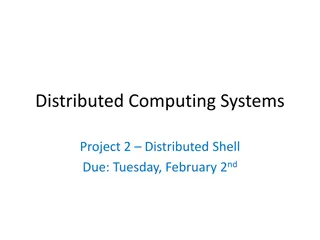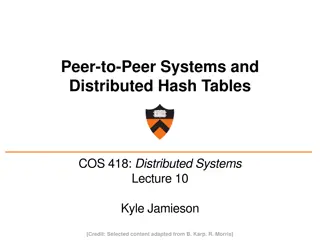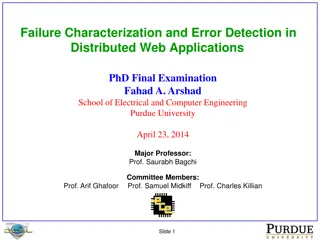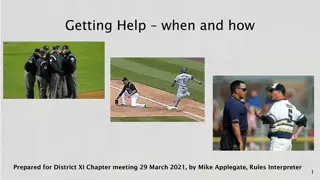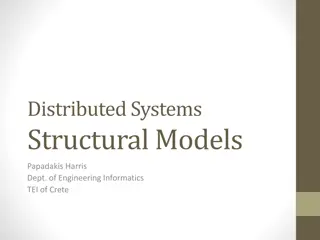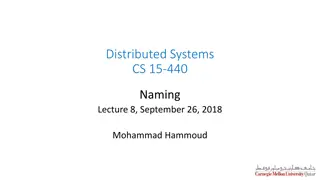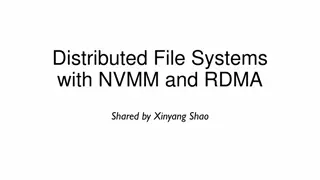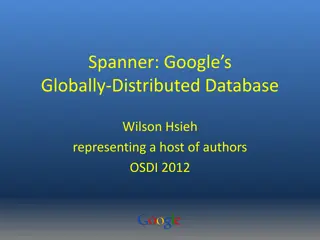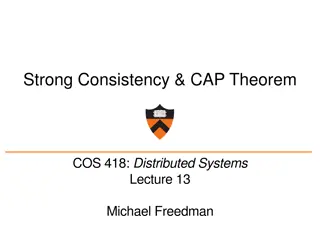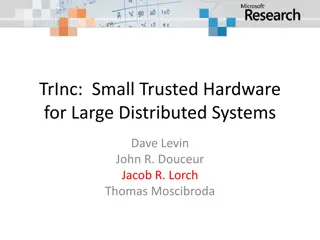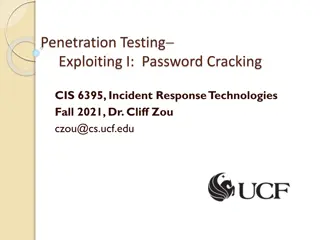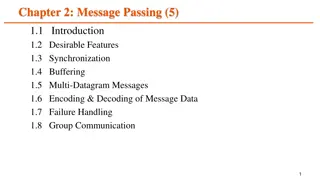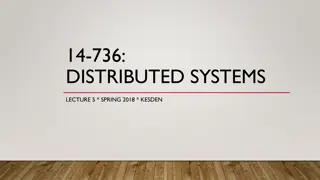Understanding Remote Procedure Calls in Distributed Systems
Explore the concept of Remote Procedure Calls (RPC) in distributed systems, including the basic RPC approach, middleware layers, transport primitives, failure types, and more. Learn how RPC enables communication between sender and receiver seamlessly, without direct message passing visible to the programmer.
Download Presentation

Please find below an Image/Link to download the presentation.
The content on the website is provided AS IS for your information and personal use only. It may not be sold, licensed, or shared on other websites without obtaining consent from the author. Download presentation by click this link. If you encounter any issues during the download, it is possible that the publisher has removed the file from their server.
E N D
Presentation Transcript
Distributed Systems CS 15-440 Remote Procedure Calls- Part II Lecture 6, September 09, 2020 Mohammad Hammoud
Today Last Session: RPC- Part I Today s Session: Continue with Remote Procedure Calls Announcement: Project I is now out. It is due on Oct 05
Middleware Layers Applications, Services Remote Invocation Middleware Layers IPC Primitives (e.g., Sockets) Transport Layer (TCP/UDP) Network Layer (IP) Data-Link Layer Physical Layer 3
Remote Procedure Calls (RPC) RPC enables a sender to communicate with a receiver using a simple procedure call No communication or message-passing is visible to the programmer Basic RPC Approach: Machine A Client Machine B Server Client Program Communication Module Communication Module Server Procedure Request int add(int x, int y) { return x+y; } add(a,b) ; Response Client process Server process Client Stub Server Stub (Skeleton)
Transport Primitives RPC communication module (or transport) is mainly based on a trio of communication primitives, makerpc(.), getRequest(.), and sendResponse(.) Client Server Request Service getRequest(.) makerpc(.) (wait) (continuation) select operation execute operation Send Results sendResponse(.) 5
Failure Types RPC systems may suffer from various types of failures Type of Failure Type of Failure Type of Failure Type of Failure Type of Failure Type of Failure Type of Failure Type of Failure Type of Failure Description Description Description Description Description Description Description Description Description Crash Failure Crash Failure Crash Failure Crash Failure Crash Failure Crash Failure Crash Failure Crash Failure Crash Failure A server halts, but was working correctly until it stopped A server halts, but was working correctly until it stopped A server halts, but was working correctly until it stopped A server halts, but was working correctly until it stopped A server halts, but was working correctly until it stopped A server halts, but was working correctly until it stopped A server halts, but was working correctly until it stopped A server halts, but was working correctly until it stopped A server halts, but was working correctly until it stopped Omission Failure Receive Omission Send Omission Send Omission Send Omission Send Omission Send Omission Send Omission Send Omission Send Omission Send Omission Omission Failure Omission Failure Omission Failure Omission Failure Omission Failure Omission Failure Omission Failure Omission Failure Receive Omission Receive Omission Receive Omission Receive Omission Receive Omission Receive Omission Receive Omission Receive Omission A server fails to respond to incoming requests A server fails to receive incoming messages A server fails to receive incoming messages A server fails to receive incoming messages A server fails to receive incoming messages A server fails to receive incoming messages A server fails to receive incoming messages A server fails to receive incoming messages A server fails to receive incoming messages A server fails to respond to incoming requests A server fails to receive incoming messages A server fails to send messages A server fails to send messages A server fails to send messages A server fails to send messages A server fails to send messages A server fails to send messages A server fails to send messages A server fails to send messages A server fails to send messages A server fails to respond to incoming requests A server fails to respond to incoming requests A server fails to respond to incoming requests A server fails to respond to incoming requests A server fails to respond to incoming requests A server fails to respond to incoming requests A server fails to respond to incoming requests Timing Failure Timing Failure Timing Failure Timing Failure Timing Failure Timing Failure Timing Failure Timing Failure Timing Failure A server s response lies outside the specified time interval A server s response lies outside the specified time interval A server s response lies outside the specified time interval A server s response lies outside the specified time interval A server s response lies outside the specified time interval A server s response lies outside the specified time interval A server s response lies outside the specified time interval A server s response lies outside the specified time interval A server s response lies outside the specified time interval Response Failure Value Failure State Transition Failure State Transition Failure State Transition Failure State Transition Failure State Transition Failure State Transition Failure State Transition Failure State Transition Failure State Transition Failure Response Failure Value Failure Value Failure Value Failure Value Failure Value Failure Value Failure Value Failure Value Failure Response Failure Response Failure Response Failure Response Failure Response Failure Response Failure Response Failure A server s response is incorrect The value of the response is wrong The server deviates from the correct flow of control The server deviates from the correct flow of control The server deviates from the correct flow of control The server deviates from the correct flow of control The server deviates from the correct flow of control The server deviates from the correct flow of control The server deviates from the correct flow of control The server deviates from the correct flow of control The server deviates from the correct flow of control A server s response is incorrect The value of the response is wrong The value of the response is wrong The value of the response is wrong The value of the response is wrong The value of the response is wrong The value of the response is wrong The value of the response is wrong The value of the response is wrong A server s response is incorrect A server s response is incorrect A server s response is incorrect A server s response is incorrect A server s response is incorrect A server s response is incorrect A server s response is incorrect Arbitrary Failure Byzantine Failure Byzantine Failure Byzantine Failure Byzantine Failure Byzantine Failure Byzantine Failure Byzantine Failure Byzantine Failure A server may produce arbitrary responses at arbitrary times A server may produce arbitrary responses at arbitrary times A server may produce arbitrary responses at arbitrary times A server may produce arbitrary responses at arbitrary times A server may produce arbitrary responses at arbitrary times A server may produce arbitrary responses at arbitrary times A server may produce arbitrary responses at arbitrary times A server may produce arbitrary responses at arbitrary times A server may produce arbitrary responses at arbitrary times 6
Timeout Mechanism To allow for occasions where a request or a reply message is lost, makerpc(.) can use a timeout mechanism There are various options as to what makerpc(.) can do after a timeout: Either return immediately with an indication to the client that the request has failed Or retransmit the request repeatedly until either a reply is received or the server is assumed to have failed How to pick a timeout value? At best, use empirical/theoretical statistics At worst, no good value exists 7
Idempotent Operations In cases when the request message is retransmitted, the server may receive it more than once This can cause an operation to be executed more than once for the same request Caveat: Not every operation can be executed more than once and obtain the same result each time! Operations that CAN be executed repeatedly with the same effect are called idempotent operations 8
Duplicate Filtering To avoid problems with operations, the server should: Identify successive messages from the same client Monotonically increasing sequence numbers can be used Filter out duplicates Upon receiving a duplicate request, the server can: Either re-execute the operation again and reply Possible only for idempotent operations Or avoid re-executing the operation via retaining its output in a non-volatile history (or log) file Might necessitate transactional semantics (more on this later in the course) 9
Implementation Choices RPC transport can be implemented in different ways to provide different delivery guarantees. The main choices are: 1. Retry request service (client side): Controls whether to retransmit the request service until either a reply is received or the server is assumed to have failed 2. Duplicate filtering (server side): Controls when retransmissions are used and whether to filter out duplicate requests at the server 3. Retention of results (server side): Controls whether to keep a history of result messages so as to enable lost replies to be retransmitted without re- executing the operations at the server 10
RPC Call Semantics Combinations of measures lead to a variety of possible semantics for the reliability of RPC Fault Tolerance Measure Fault Tolerance Measure Fault Tolerance Measure Call Semantics (Pertaining to Retransmit Request Message Message Message Retransmit Request Retransmit Request Duplicate Filtering Duplicate Filtering Duplicate Filtering Re-execute Procedure or Retransmit Reply Retransmit Reply Retransmit Reply Re-execute Procedure or Procedure or Re-execute Call Semantics Call Semantics Remote Procedures) No No No N/A N/A N/A N/A N/A N/A Maybe Maybe Maybe Yes Yes Yes No No No Re-execute Procedure Procedure Procedure Re-execute Re-execute At-least-once At-least-once At-least-once Yes Yes Yes Yes Yes Yes Retransmit Reply Retransmit Reply Retransmit Reply At-most-once At-most-once At-most-once Ideally, we would want an exactly-once semantic! 11
Middleware Layers Applications, Services Remote Invocation Middleware Layers IPC Primitives (e.g., Sockets) Transport Layer (TCP/UDP) Network Layer (IP) Data-Link Layer Physical Layer 12
RPC over UDP or TCP If RPC is layered on top of UDP Retransmission shall/can be handled by RPC If RPC is layered on top of TCP Retransmission will be handled by TCP Is it still necessary to take fault-tolerance measures within RPC? Yes-- read End-to-End Arguments in System Design by Saltzer et. al.
Careful File Transfer: Flow Endpoint 1 Endpoint 2 File Transfer App File Transfer App 5. Send F 6. Rcv F DCS DCS 4. Return F 1. Read F 7. Write F OS (which includes a LFS) OS (which includes a LFS) 3. Return F 2. Read F 8. Write F F F DCS = Data Communication System; LFS = Local File System
Careful File Transfer: Possible Threats Endpoint 1 Endpoint 2 File Transfer App 1. Faulty App File Transfer App 1. Faulty App 5. Flaky 5. Send F 6. Rcv F Communication DCS DCS 4. Return F 1. Read F 7. Write F OS (which includes a LFS) OS (which includes a LFS) 2. Faulty LFS 2. Faulty LFS 3. Return F 2. Read F 8. Write F 4. Corrupted F 4. Corrupted F F F 3. Faulty HW Component 3. Faulty HW Component DCS = Data Communication System; LFS = Local File System
Careful File Transfer: End-To-End Check and Retry Endpoint 1 stores with F a checksum CA After Endpoint 2 writes F, it reads it again from disk, calculates a checksum CB, and sends it back to Endpoint 1 Endpoint 1 compares CA and CB If CA = CB, commit the file transfer Else, retry the file transfer
Careful File Transfer: End-To-End Check and Retry How many retries? Usually 1 if failures are rare 3 retries might indicate that some part of the system needs repair What if the Data Communication System uses TCP? Only threat 5 (e.g., packet loss due to a flaky communication) is eliminated The frequency of retries gets reduced if the fault was caused by the communication system More control traffic, but only missing parts of F need to be reshipped The file transfer application still needs to apply end-to-end reliability measures!
Careful File Transfer: End-To-End Check and Retry What if the Data Communication System uses UDP? Threat 5 (e.g., packet loss due to a flaky communication) is NOT eliminated- F needs to be reshipped by the application if no measures are taken to address this threat The frequency of retries might increase Worse performance on flaky links The file transfer application still needs to apply end-to-end reliability measures! In both cases, the application needs to provide end-to-end reliability guarantees!
Next Class Architectures




